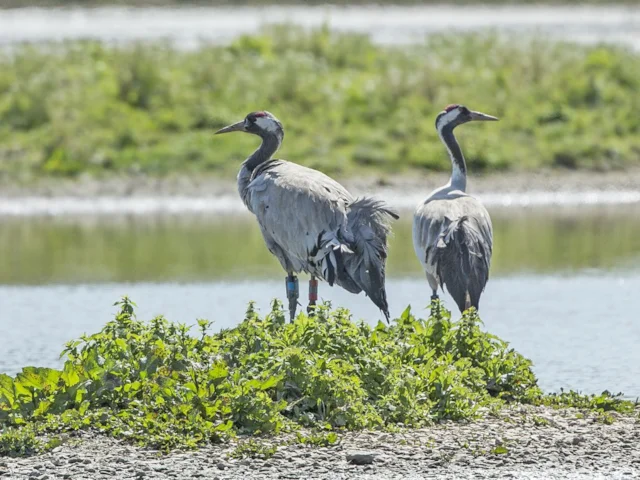Reintroduced crane breeding delayed by late spring
52f201e7-8253-4c75-bcd9-1c3f712baa1f

A Common Crane has laid its first egg three weeks late at Slimbridge WWT Wetland Centre in Gloucestershire, as colder weather holds back spring for much of the natural world.
The female bird, Ruby, and its partner Bart are derived from the ongoing Great Crane Project reintroduction scheme, and gave staff and volunteers at Slimbridge a pleasant surprise last Thursday when they quickly built a nest and Ruby started sitting.
Staff and volunteers set up a watch to protect the cranes against egg thieves, and are on hand in a hide to show the birds to the public. The nest is also protected by heat sensitive camera traps, which will record evidence of any disturbance. Elsewhere on the reserve, ditches have been deepened and fences put up to deter Foxes and Badgers, after predators killed two crane chicks last spring.
Slimbridge WWT Reserve Warden Martin McGill said: “This time last year we were watching for the first crane eggs to hatch, but Ruby and Bart have only just nested. It’s a late spring for the natural world. There’s less grass and vegetation and there aren’t as many insects, so the cranes’ natural response is to put off breeding.
“Now that they have nested, we’re obviously delighted. They’ve chosen a good spot surrounded by water, where several pairs of geese have already successfully raised young this year. That’s a good sign that it’s relatively safe from predators. We’re doing all we can to protect Ruby and Bart’s nest without disturbing them.”
Ruby and Bart were hand-reared in 2010 and released as part of the Great Crane Project, a partnership between WWT, RSPB, Pensthorpe Conservation Trust and Viridor Credits, which reintroduced nearly 100 Common Cranes to the West Country. The project’s aim is to restore the species to its former haunts across the UK – giving birds that naturally re-colonised in the 1970s a leg up. They were heavily hunted and eventually driven to extinction in Britain when large areas of wetland were drained in the 1600s.
Ruby and Bart made their first attempt to breed last year but failed to hatch either of their eggs. At just five years old, they are relatively young to be breeding Common Cranes and it’s hoped that they will have learned from their experience. Another pair – Christine and Monty – have nested at WWT Slimbridge for the last two years, and last year managed to hatch the first chicks in western Britain for 400 years, which were sadly killed by predators before they were fully grown. So far this year Christine and Monty have shown interest in their usual nest site right in front of one of the hides, but they haven’t settled down yet.
For information on cranes, including what to do if you see one visit www.wwt.org.uk/cranes.
The female bird, Ruby, and its partner Bart are derived from the ongoing Great Crane Project reintroduction scheme, and gave staff and volunteers at Slimbridge a pleasant surprise last Thursday when they quickly built a nest and Ruby started sitting.
Staff and volunteers set up a watch to protect the cranes against egg thieves, and are on hand in a hide to show the birds to the public. The nest is also protected by heat sensitive camera traps, which will record evidence of any disturbance. Elsewhere on the reserve, ditches have been deepened and fences put up to deter Foxes and Badgers, after predators killed two crane chicks last spring.
Slimbridge WWT Reserve Warden Martin McGill said: “This time last year we were watching for the first crane eggs to hatch, but Ruby and Bart have only just nested. It’s a late spring for the natural world. There’s less grass and vegetation and there aren’t as many insects, so the cranes’ natural response is to put off breeding.
“Now that they have nested, we’re obviously delighted. They’ve chosen a good spot surrounded by water, where several pairs of geese have already successfully raised young this year. That’s a good sign that it’s relatively safe from predators. We’re doing all we can to protect Ruby and Bart’s nest without disturbing them.”
Ruby and Bart were hand-reared in 2010 and released as part of the Great Crane Project, a partnership between WWT, RSPB, Pensthorpe Conservation Trust and Viridor Credits, which reintroduced nearly 100 Common Cranes to the West Country. The project’s aim is to restore the species to its former haunts across the UK – giving birds that naturally re-colonised in the 1970s a leg up. They were heavily hunted and eventually driven to extinction in Britain when large areas of wetland were drained in the 1600s.
Ruby and Bart made their first attempt to breed last year but failed to hatch either of their eggs. At just five years old, they are relatively young to be breeding Common Cranes and it’s hoped that they will have learned from their experience. Another pair – Christine and Monty – have nested at WWT Slimbridge for the last two years, and last year managed to hatch the first chicks in western Britain for 400 years, which were sadly killed by predators before they were fully grown. So far this year Christine and Monty have shown interest in their usual nest site right in front of one of the hides, but they haven’t settled down yet.
For information on cranes, including what to do if you see one visit www.wwt.org.uk/cranes.

